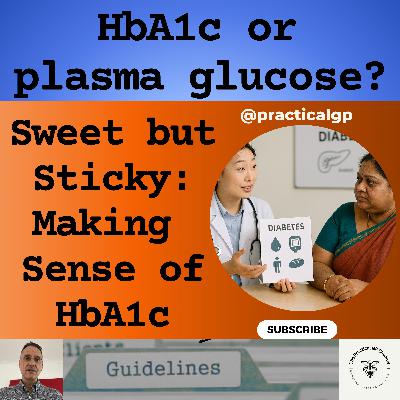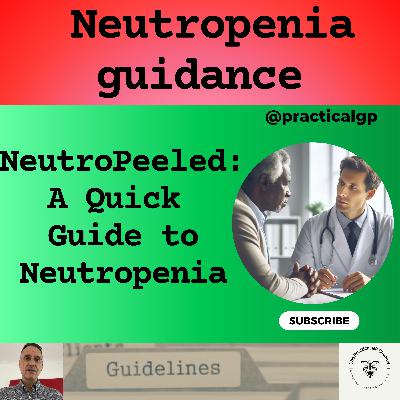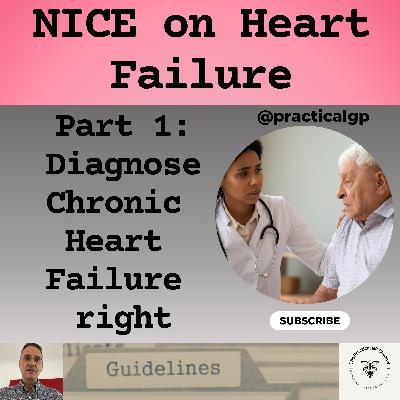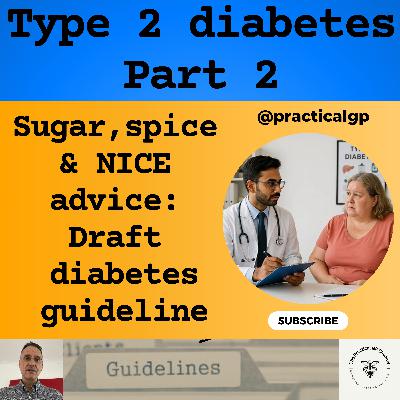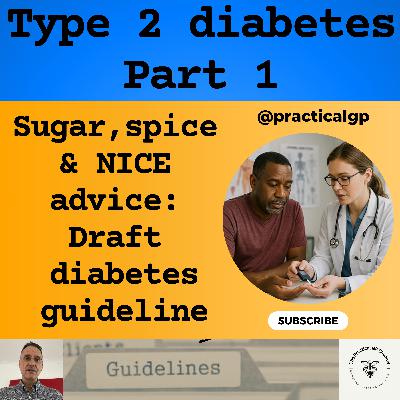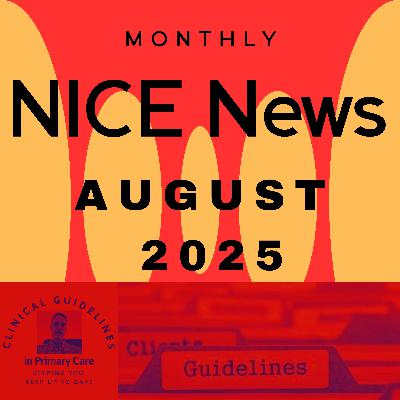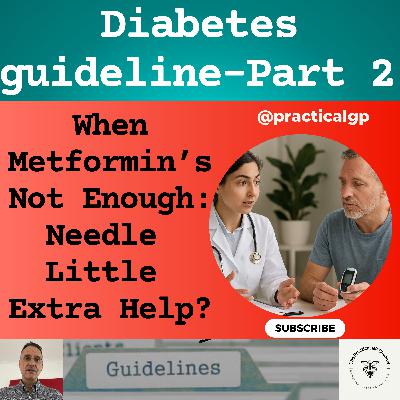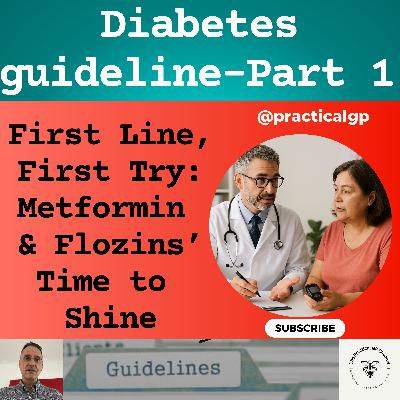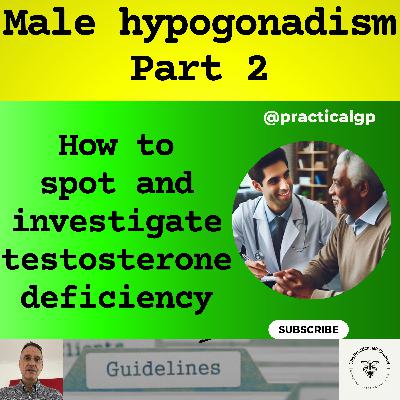Podcast - Sweet but Sticky: Making Sense of HbA1c
Description
The video version of this podcast can be found here:
· https://youtu.be/t8U8-isTieM
This episode makes reference to guidelines produced by the "National Institute for Health and Care Excellence" in the UK, also referred to as "NICE". The content on this channel reflects my professional interpretation/summary of the guidance and I am in no way affiliated with, employed by or funded/sponsored by them.
NICE stands for "National Institute for Health and Care Excellence" and is an independent organization within the UK healthcare system that produces evidence-based guidelines and recommendations to help healthcare professionals deliver the best possible care to patients, particularly within the NHS (National Health Service) by assessing new health technologies and treatments and determining their cost-effectiveness; essentially guiding best practices for patient care across the country.
My name is Fernando Florido and I am a General Practitioner in the United Kingdom. In this episode I go through recommendations on the diagnosis and monitoring of type 2 diabetes, which includes guidance by NICE. The links to the NICE guideline is in the episode description.
I am not giving medical advice; this video is intended for health care professionals, it is only my summary and my interpretation of the guidelines and you must use your clinical judgement.
Disclaimer:
The Video Content on this channel is for educational purposes and not intended to be a substitute for professional medical advice, diagnosis, or treatment. Always seek the advice of your physician or other qualified health provider with any questions you may have regarding a medical condition. Never disregard professional medical advice or delay in seeking it because of something you have read or seen on this YouTube channel. The statements made throughout this video are not to be used or relied on to diagnose, treat, cure or prevent health conditions.
In addition, transmission of this Content is not intended to create, and receipt by you does not constitute, a physician-patient relationship with Dr Fernando Florido, his employees, agents, independent contractors, or anyone acting on behalf of Dr Fernando Florido.
Intro / outro music: Track: Halfway Through — Broke In Summer [Audio Library Release]
- Music provided by Audio Library Plus
- Watch: https://youtu.be/aBGk6aJM3IU
- Free Download / Stream: https://alplus.io/halfway-through
There is a podcast version of this and other videos that you can access here:
Primary Care guidelines podcast:
· Redcircle: https://redcircle.com/shows/primary-care-guidelines
· Spotify: https://open.spotify.com/show/5BmqS0Ol16oQ7Kr1WYzupK
· Apple podcasts: https://podcasts.apple.com/gb/podcast/primary-care-guidelines/id1608821148
There is a YouTube version of this and other videos that you can access here:
- The Practical GP YouTube Channel:
https://youtube.com/@practicalgp?si=ecJGF5QCuMLQ6hrk
The NICE guideline on Type 2 diabetes in adults: management [NG28] can be found here:
· https://www.nice.org.uk/guidance/ng28
Transcript
If you are listening to this podcast on YouTube, for a better experience, switch to the video version. The link is in the top right corner of the video and in the episode description.
Hello and welcome! I’m Fernando, a GP in the UK. In today’s episode, we’ll go through recommendations on the diagnosis and monitoring of type 2 diabetes using HbA1c, focusing on what is relevant in primary care only. This information includes guidance by NICE contained in the NICE guideline on Type 2 diabetes. The link to it is in the episode description.
Right, let’s jump into it.
Let’s start with the diabetic diagnostic thresholds. They could be:
- An HbA1c of 48 mmol/mol or 6.5% or more or
- A Fasting plasma glucose level of 7.0 mmol/L or more or
- A Random plasma glucose of 11.1 mmol/L or more in the presence of symptoms or signs of diabetes.
Why have these thresholds been chosen?
These thresholds are based on the evidence of glucose levels at which the risk of diabetes-related complications—particularly retinopathy—increases significantly.
They have been agreed in order to strike a balance between diagnostic accuracy and early intervention, helping to catch diabetes at a point where treatment can prevent progression and complications.
And let’s also remember that if the person has symptoms of diabetes, a single abnormal HbA1c or fasting plasma glucose level can be used, although repeat testing is always advisable to confirm the diagnosis.
However, If the person is asymptomatic, we should not diagnose diabetes on the basis of a single abnormal HbA1c or plasma glucose result. Instead, we should arrange repeat testing, preferably with the same test, to confirm the diagnosis. If the repeat test result is normal, we will monitor the person for the development of diabetes, and the frequency of such monitoring will depend on our clinical judgement.
This guidance to not diagnose diabetes in an asymptomatic person based on a single abnormal result is based on principles of biological variability, and the importance of avoiding misdiagnosis.
This is because Glucose levels and HbA1c can fluctuate due to a variety of reasons and a single abnormal result may not reflect the person's usual glycaemic status. Repeating the test helps rule out false positives due to possible transient factors or a lab artefact or error.
Can we use HbA1c and plasma glucose interchangeably to diagnose type 2 diabetes?
Well, in general, yes, but there are times when HbA1c should not be used to diagnose diabetes. This is the case for:
- Children and young people under the age of 18.
- Pregnant women or women within 2 months postpartum.
- People with symptoms of diabetes for less than 2 months.
- People at high diabetes risk who are acutely ill.
- People taking medication that may cause hyperglycaemia (for example, long-term corticosteroids).
- People with acute pancreatic damage, including pancreatic surgery.
- And People with end-stage renal disease (ESRD).
Additionally, HbA1c should be interpreted with caution in people with abnormal red blood cell turnover or abnormal haemoglobin type, like:
- Abnormal haemoglobin, such as haemoglobinopathy, including sickle cell trait.
- Severe anaemia (of any cause).
- Altered red cell lifespan (for example, in post-splenectomy).
- And a recent blood transfusion.
Why do we need caution in these situations?
Well, HbA1c reflects the percentage of haemoglobin that has glucose attached to it—essentially giving us an average of blood glucose over the past 2 to 3 months, which is the typical lifespan of a red blood cell. However, anything that alters red blood cell turnover or haemoglobin structure can affect the accuracy of this measurement. For example:
- In conditions like haemoglobinopathies (e.g. sickle cell trait or thalassaemia), the structure of haemoglobin is different, which can interfere with how HbA1c is measured or how glycation occurs.
- In severe anaemia or increased red cell turnover, red blood cells are cleared from the circulation more quickly, so there’s less time for glucose to attach—leading to falsely low HbA1c.
- Conversely, if red cells live longer than normal (such as after splenectomy), HbA1c may be falsely high because glucose has more time to accumulate.
- And finally, after a recent blood transfusion, the donor’s red blood cells—often with a different glycaemic history—can distort the result.
So, in these cases, HbA1c may not accurately reflect the patient’s glycaemic control, and alternative measures like fasting glucose or an oral glucose tolerance test may be more reliable.
What about diabetic monitoring?
NICE recommends that we should measure HbA1c levels in adults with type 2 diabetes:
- Every 3 to 6 months until HbA1c is stable on unchanging therapy or
- Every 6 months once the HbA1c and diabetic therapy are stable.
If HbA1c monitoring is invalid because of disturbed erythrocyte turnover or abnormal haemoglobin type, we will need to estimate trends in blood glucose control using one of the following:
- quality-controlled plasma glucose profiles
- total glycated haemoglobin estimation (if there are abnormal haemoglobins) or
- fructosamine.
What do these alternative forms of monitoring involve?
Well:
- Quality-controlled plasma glucose profiles involve measuring fasting an

